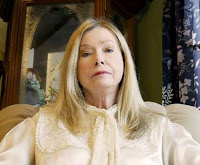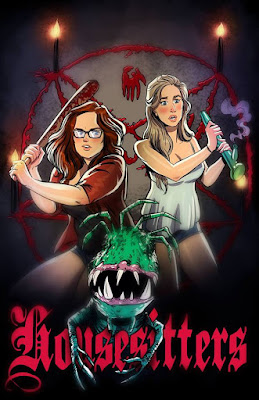Text © Richard Gary / Indie Horror Films, 2018
Images from the Internet
Twilight People
Directed by Eddie Romero
VCI
Entertainment / MVD Visual
81
minutes, 1972 / 2018
I have two
converging thoughts about this release in a general way, before I get into
specifics. The first is that I remember in the early-to-mid-1970s when there
was a host of Philippines-shot films that were showing up in the theaters,
though I was too young at the time to realize they were mostly directed by the
same guy, Eddie Romero, including Women
in Chains (1973, also known as Black
Mama, White Mama). Most of his output at that time were about people being
held against their will (either convicts or kidnap victims), and them being
tortured and/or turned into some kind of monster, such as animal or zombie.
My second
thought is about handsome actor John Ashley. He started out mostly in shirtless
in a bunch of beach and gangster films in the early 1960s, and ended up making
numerous horror films… wait for it… in the Philippines. And yes, for Eddie
Romero, such as Mad Doctor of Blood Island (1968), Beast of Blood (1970), Beast
of the Yellow Night (1971; I remember cutting out of school to go see it), and this
one, each directed by, yep, Eddie Romero. These even helped create a sub-genre
called the Blood Island Films.
Now, while
these films get accolades now, and Romero has won lots of awards (especially
from the Philippines), the truth of the matter is most from this period and
genre are cheesy messes; but the good side of the coin is that is also part of what
makes them such a joy to watch. It is one solid WTF moment after another, be it story, make-up effects, acting, and
so on. But I’ll get more into detail as I go along.
 Sporting Tom
Jones-level sideburns, soldier of fortune, adventurer and man-about-town Matt
Farrell (Ashley; d. 1997) – who is repeatedly called by his last name
throughout – is kidnapped while SCUBA diving by blond Robert-Shaw-in-From Russia With Love-wannabe Steinman (Jan
Merlin, who perennially played bad guys, especially in Westerns) and the
luscious but icy looking brunette Neva (Pat Woodell, who played Bobby Jo in
“Petticoat Junction”; d. 2015). The man behind the plot is Dr. Gordon (Charles
Macaulay, better known as Landru to “Star Trek” fans, and Dracula in Blacula; d. 1991).
Sporting Tom
Jones-level sideburns, soldier of fortune, adventurer and man-about-town Matt
Farrell (Ashley; d. 1997) – who is repeatedly called by his last name
throughout – is kidnapped while SCUBA diving by blond Robert-Shaw-in-From Russia With Love-wannabe Steinman (Jan
Merlin, who perennially played bad guys, especially in Westerns) and the
luscious but icy looking brunette Neva (Pat Woodell, who played Bobby Jo in
“Petticoat Junction”; d. 2015). The man behind the plot is Dr. Gordon (Charles
Macaulay, better known as Landru to “Star Trek” fans, and Dracula in Blacula; d. 1991).
Okay, so now
that is out of the way, Farrell is brought to Dr. Gordon’s island fortress
(where did he get the money?), to which Farrell presciently asks, “What is this
circus?” It’s a good question because the good
doctor wants to help science and humanity by combining humans with animals. If
it sounds like HG Well’s The Island of
Dr. Moreau (enjoyable book, by the way), you wouldn’t be the first to
agree, and I would not either; hell it says it right on the back cover of this
edition. But to add to the mix, I would say it also seems to rely some on
1958’s She Demons, also set on an island
with a doctor playing havoc with the human form (mostly female, of course).
 |
| Pat Woodell and Pam Grier |
Unlike those
other two, however, this film really can’t seem to make up its mind to its
genre, exactly. Okay, it is a horror, especially the Mad Scientist type, but at
some point it’s a war film and a bit of a Western. There’s also some humor
thrown in here and there, but I’m not sure if it’s intentional or not; either
way, I’ll take it. And enjoy it.
Most of the
humor lies in the transformed creatures, including a panther woman (an early
role for the great Pam Grier), an ape man (Kim Ramos), a real bat man who
steals his scenes (Tony Gosalvez), and a surprisingly touching romance between
an antelope man (Ken Metcalfe) and wolf woman (Mona Morena). Oh did I mention
that these two aren’t the only romance that develops in the plot? Of course, in
a post-James Bond world it will come as no surprise. Near the end, though, is a
nice twist.
There is
actually a large albeit subtle level of sensuality/sexuality that surprised me
a bit, even for its time period (Hammer Films was releasing cleavage-fests by then).
There’s a (clothed) love scene, an almost rape, some formidable décolletage by Grier, a tight tee, Woodell is
always in full makeup even in the jungle all night, and there is even some
strong suggestion about mano-a-mano-amor.
Of course, the only rolling-on-the-ground hand-to-hand combat is between two females
(girl fight!): panther woman and wolf
woman, who you might say were at it like – err
– cats and dogs.
 |
| Wolf Woman and Antelope Man in love |
So there is a ridiculousness level to the film,
such as the make-up (by Tony Arteida), sometimes the acting, guns with never-ending
amounts of bullets, the animal sounds on the soundtrack that are dubbed to
supposedly be “dialogue” by our (mostly) friendly humanimals (even though they
never match up to anything), and lots of story holes. What I mean by the latter
is that things happen that are never explained (wait, you had the drop on him…), or the editing is confusing, and
the whole finale is a “Hunh? You’re
ending it here?”
It might be wise here to let you know that while there isn't a large amount of gore, there is some nice bloodletting, though the blood is a really bright shade of red. Being humanimals, there is a lot of throat-tearing.
The basic
extras are the theatrical and TV trailers, but there is also a 58:40 minute
interview with the director, Eddie Romero (d. 2013), that a bit dated as it
looks like it was transferred from a VHS). It’s a single camera focused on the director
as he answers off-screen questions about how he got into the film industry, discusses
Filipino cinema history, and supplies anecdotes about his own films. He’s personable
and it’s interesting; that being said, it’s a tad long, albeit historically important.
 |
| Na-na-na-na-na-na-na-na Bat Man |
Also included
is a full-length commentary by film historian David Del Valle and low-budget
genre director David Decoteau. Luckily, there are English subtitles available,
so you can watch the film with the commentary and still follow the story. Their
conversation is more film history, both horror and Filipino, than about this film directly, but I still recommend
watching the feature first without the comments, and then listening to it to avoid distraction to either. It’s a bit
dry, but I’m used to academic kind of lectures and certainly find film history
interesting, but I would understand if it wasn’t everyone’s cuppa. While it
definitely is thought-provoking from a film nerd point of view, and they
discuss Filipino cinema in detail as well as the numerous actors, they don’t
address the two key plot questions I have, which I won’t give away here.
Oh, and did I
mention the package comes with both a 2K format Blu-ray and a DVD? This has definitely been cleaned up, and the picture quality
is stunning in both.
My biggest
question about this film though, is simply this: is it Twilight People or THE
Twilight People. I have seen it both ways. Either way, it’s a hooterville-and-half.























